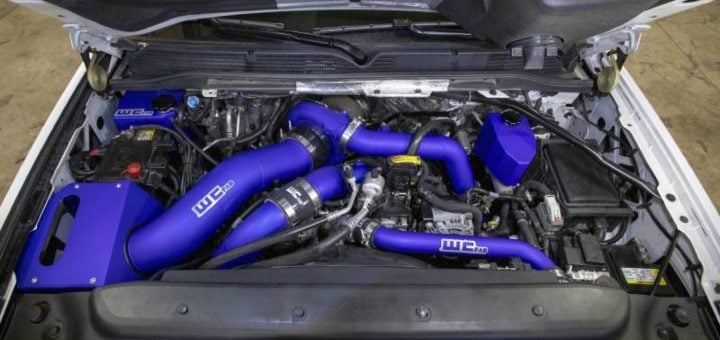The 7 Best Duramax LLY Performance Upgrades

Meet Jake
Jake is a founder of 8020 Media and has been creating automotive content online since 2017. He has been the lead writer for Chevy Trucks and has transformed it from the old and outdated site it was into what it is today. Jake creates a ton of GM related content for the 8020 Media YouTube channel and specializes in Duramax and Vortec information but has a wealth of knowledge across all GM cars and engines. Jake believes the L5P is the best diesel on the market today.
With the capability of the stock turbocharger, the LLY Duramax left tons of power on the table. These engines are capable of pushing beyond 500rwhp with just a few bolt-on mods, and an upgraded transmission.
In this guide we are going to cover the LLY’s power limits and discuss the 7 best performance upgrades to add over 200whp and torque: turbo inlets, intakes, tuning, exhaust, turbocharger upgrades, as well as supporting lift pump and transmission upgrades.

LLY Power Limits
- Transmission: the Allison transmission can handle about 400whp before requiring tuning. At around 500whp it will need to be fully built. (Manual transmissions can handle over 600whp without any mods)
- Connecting Rods: only good for about 600whp, so you’ll need some internal upgrades to push past these levels
- Lift Pump: strongly suggest adding one before tuning, becomes an absolute requirement at 500whp but realistically you need one right away
- Stock Turbo: can handle about 500whp, you can push it all the way up to around 530whp but that will result in it blowing relatively easily
- Stock Fueling: the injectors and fuel pump are good for about 600whp before needing upgrades
If you would rather consume this content via a video, check out our Best Duramax LLY Mods video below:
Best Duramax LLY Performance Upgrades
- Turbo Inlet Manifold
- Lift Pump
- Exhaust System
- EFI Live Tuning
- Intake
- Transmission
- Turbocharger
1) Turbo Inlet Manifold
Circling back to the engine’s overheating problem, it was primarily due to its restrictive turbo inlet manifold. The design of the stock turbo inlet manifold, also known as the turbo mouthpiece, was restrictive and hindered airflow into the turbo. Consequently, it impacted the turbo spool as the turbocharger struggled to build up adequate boost, leading to heightened exhaust gas temperature. Replacing the turbo mouthpiece should be the first modification when improving engine performance, as making any other modification without replacing this piece is simply asking for trouble.
Any mouthpiece other than the stock mouthpiece is a better improvement. However, most drivers prefer to opt for LBZ’s stock mouthpiece because it is an inexpensive alternative that is equally as good as most aftermarket units — it improves airflow, turbo spool and eliminates the risk of overheating. The only downside of the LBZ mouthpiece is that you’ll have to cut the intake tube for it to fit. With most aftermarket units, you don’t need to modify the intake tube because they fit perfectly, but they cost more than the LBZ unit.
2) Lift pump: FASS 165gph

Considering that the newer LLY aimed to fix all the issues that plagued the LB7, it was surprising that the LLY still didn’t have a lift pump. Instead, the engine relied solely on the Bosch CP3 injection pump to pull the fuel from the tank.
A lift pump is highly recommended before you add tuning. A lift pump is going to increase the longevity of your CP3 pump as well as your fuel injectors, both of which are expensive to replace. It’s a must-have mod, and you should do this and the turbo inlet before any other mod.
You can get a 100gph system which will support around 550whp, but I highly recommend spending an extra $50 and getting a 165gph system which can handle about 800whp. The extra capacity will prevent it from running at 90%+ capacity, helping longevity and reliability.
Price: $679-$729
Buy Here: FASS 165gph Duramax LLY Lift Pump
2) Downpipe & Exhaust System
Opening up the exhaust side to allow for the free flow of exhaust gas is another way to gain more horsepower. This enables the engine to breathe better and reduces the exhaust gas temperature. Not only will this improve performance, but it also eliminates the risk of overheating when you tune the engine for more power.
Downpipe
The squished stock downpipe is not an optimal design for exhaust gas flow. The exhaust system is 3.5″ with odd bends, a catalytic converter, and a muffler for noise and emission reduction. Improving the engine performance without opening up the exhaust side to allow easy exit of exhaust gas could cause back pressure, increasing the exhaust gas temperature.
Replacing the downpipe is the best exhaust modification on the LLY. Since it bolts directly to the turbocharger it has the greatest increase in backpressure reduction therefore resulting in the biggest increases to turbocharger efficiency.
MBRP’s downpipe fits perfectly and comes with a protective heat shield. This replacement improves the flow of exhaust gases from the turbocharger into the exhaust system. Consequently, it enhances the turbo spool, resulting in more power, and further helps cool down the EGTs.
4″ Exhaust System
The downpipe-back portion of the exhaust system is where you are going to get the 2nd best performance gains, behind a downpipe. Getting a cat-back exhaust will help further reduce backpressure and EGTs leading to more power and lower engine temps.
Now, the LLY has a catalytic converter in most models. Upgrading the downpipe + getting a 4″ catback will run you around $600. If your truck doesn’t have, or doesn’t require, a catalytic converter, then the LB7 exhaust is a direct bolt-on and is turbo-back for only $399 which would be the best option and cheapest.
Price: $419.99
Buy Here: MBRP 4″ Cat-Back Exhaust Systems | Duramax LB7 Exhaust (Direct Bolt-on)
3) EFI Live ECM Tuning
Opting for custom tuning after upgrading the turbo mouthpiece and exhaust assembly will bring significant power gains. You can contact a reputable dealer to write the tune for you if you don’t know how to go about it. While you are at it, remember to discuss what modifications you currently have on your truck and your future plans.
With EFI Live, you get a customized tune tailored to your needs and don’t have to worry about ruining your transmission, provided you keep things around 400HP and 650 lb-ft of torque.
Pushing the LLY Beyond 500whp
You’ll need to make substantial modifications to the truck for more significant power gains beginning with the weak spots. If you intend to push the engine beyond 500HP from the start, be sure to make all the modifications pointed out above except for EFI Live tuning. You should save the customized tuning for later when you’ve made all the performance modifications you intend to do on the truck.
5) Cold Air Intake
After opening up the exhaust side and increasing the fuel supply, the next step is to improve the intake air supply to balance the equation. An aftermarket intake from Banks will drastically reduce restriction, allowing the engine to inhale better. You should also expect more horsepower and improved fuel economy.
For more details on performance benefits and best LLY intakes, check out our extensive Duramax LLY Intake Upgrade Guide
6) Allison 1000 Transmission Upgrades
Throughout the production run, they mated the LLY Duramax engines to an Allison transmission. The engine debuted with a five-speed Allison Transmission in 2004, which was later upgraded to a six-speed Allison transmission in 2006. These transmissions were dependable and built to last long, but only with the stock power. Although you can still do some decent modding with the stock transmission, the rule of thumb was to keep it under 90HP or increase the chances of catastrophic failures.
You’ll have to build the transmission to hold the power you want it to handle. Rebuilding a transmission is more complicated and labor-intensive than an engine, so it is best to contact an expert if you aren’t up to the task. There are several ways to go about the process — source parts individually, opt for complete kits, or take the easy way out by settling for ready-to-install units.
However, before proceeding, you should be sure about what horsepower levels you want, as this would determine what upgrades your transmission needs. Starting with upgrading the stock clutch to allow for a quicker and smoother shift, triple disk performance torque converter, and installing a Trans-Go Shift kit to increase clutch holding power.
There are various offers on the market for drop-in units, with 550HP, 750HP, and 750+HP builds being the most popular. For daily drivers looking to step things up a bit using the stock turbo and fuel system, a 550HP build should cut it. However, if you want to take performance to the next level by upgrading the turbocharger and fuel system, the 750HP build was designed for such power. Then there is the 750+HP build designed for much higher horsepower and people looking to push their truck’s limit.
7) Bigger Turbocharger
Before you decide to go this route, you need to answer the following questions — what kind of power are you looking to make, what are you using your truck for, and most importantly, are you sticking with the stock fuel system?
With the right supporting modifications, LLY’s stock turbo can handle up to 560HP. You should only consider upgrading the turbocharger for horsepower gains upward of 600HP. A 64MM turbo from Duramax Tuner or Ryan’s Diesel Services would support up to 650HP, and with the lift pump assisting the CP3 pressure pump, you shouldn’t have any issues running the engine at this power level.
However, if you decide to go beyond 650HP, you’ll need a bigger turbo, like 68MM. You’ll also have to upgrade the Y-bridge. The Y-bridge tends to blow out at high boost levels, causing boost leaks, and opting for a bigger turbocharger without making the necessary improvements to the fuel system limits the turbo’s performance. Yet, a big turbo may not be the most efficient choice in some situations — If you consistently tow with your truck, a big turbo introduces surges when hauling heavy loads at low RPM.
A compound turbo setup would be a better option for drivers who regularly tow heavy load and wants more power. You’ll also need to rebuild the engine to handle the power, and except you are running a twin setup, bigger turbochargers also experience more lag.
Summary
Although the LLY Duramax was rated for 310HP and 605 lb/ft of torque, the factory turbo had the capacity to support way more power. However, the major limitation to pushing the engine for significant power gains was the stock Allison transmission which peaked around 400whp, followed by the turbocharger and lack of a lift pump.
Despite these limitations, you can still push the engine to gain considerable power by making slight modifications. By improving the restrictive turbo mouthpiece and freeing up the exhaust side, you can conveniently make 400-425whp while running mostly stock components. However, things get really pricey when you decide to push the engine limits.









So I’m planning to pull a 40 ft trailer I’m licensed 28000 which usually I’m right to my limit what mods are the best
Turbo inlet for sure + intake, exhaust, and tuning. Trans tuning would be great too.